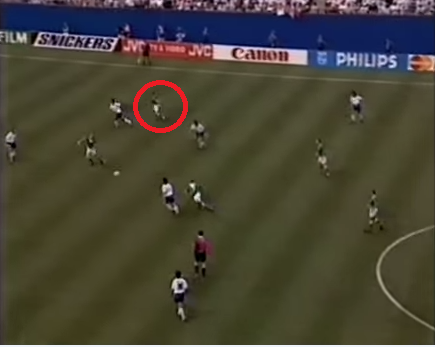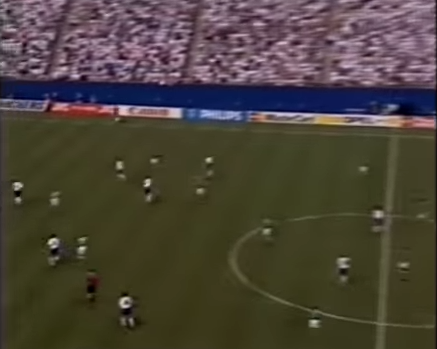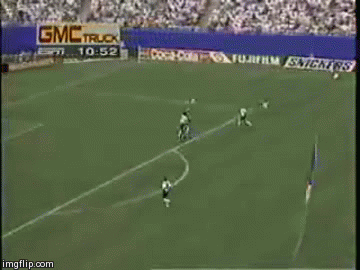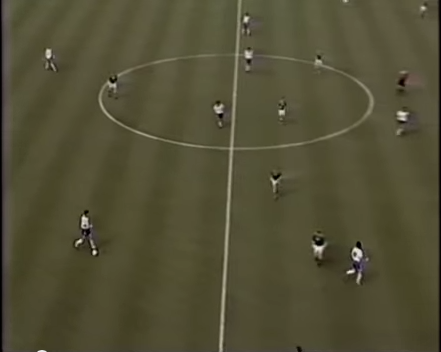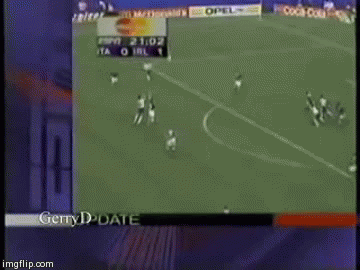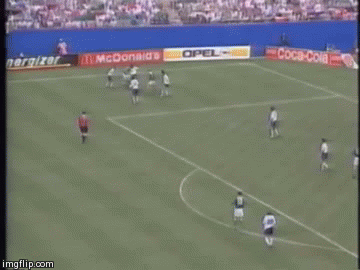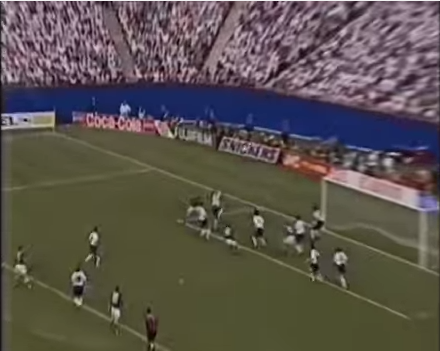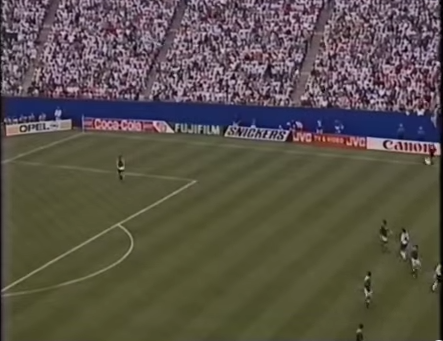ALTHOUGH JACK CHARLTON had long since established the Republic of Ireland as a respected international side by the time the 1994 World Cup rode around, few people gave them a chance of securing their first-ever (non-penalty-kick) World Cup victory on 18 June 1994.
They came up against Italy — a team with arguably the richest footballing history of any European side at the time, who had won the World Cup only 12 years previously, who had qualified for USA 94 by topping their group and losing only once while doing so and who, of course, had knocked Ireland out of the same competition four years previously.
They also boasted the then-reigning World Player of the Year within their ranks — Juventus star Roberto Baggio. Much was made over whether Ireland’s central defensive pairing of the injury-prone Aston Villa star Paul McGrath and a young, inexperienced Coventry defender, Phil Babb, could cope with the threat of Serie A’s greatest talent at the time.
Furthermore, unlike Italy, Ireland had scraped through qualification on goals scored, ahead of Denmark. They had an ageing side, with players such as Ray Houghton, Pat Bonner and McGrath having been veterans of the international set-up, all appearing during Ireland’s memorable-but-distant Euro 88 campaign. They were hampered by the absence of key striker Niall Quinn through injury, with Jack Charlton opting to start Motherwell’s Tommy Coyne in his place.
There was one good omen for Ireland ahead of the match, however. While the sight of Baggio and prolific Lazio star Giuseppe Signori starting up front together may have looked daunting to most Irish observers, some Italians felt the duo playing together in the team brought bad luck — the last time they had both featured in the Italy side was during an embarrassing defeat by a fourth division outfit in a practice game.
And despite the formidable aura surrounding the Italian team, there was an air of optimism in the RTE studio ahead of the match. Both John Giles and Frank Stapleton backed a draw (though the former “feared for Ireland” if they went a goal down), while Joe Kinnear, somewhat prophetically, tipped Ireland to win 1-0.
Formations
On the face of it, Italy started with a classic 4-4-2, while Ireland played 4-5-1.
Denis Irwin was given the nod at right-back despite coming under pressure from Leeds’ emerging youngster Gary Kelly. Tommy Coyne was picked as the lone frontman, while Jack Charlton preferred Phil Babb to Alan Kernaghan at centre-back, despite the latter having started their final World Cup qualifier against Northern Ireland. Ray Houghton also kept his place in the team, notwithstanding the emergence of another promising youngster, Bolton’s Jason McAteer.
(Though Ireland adopted a 4-5-1 formation without the ball, they often played with a second striker when attacking early on)
Ireland invariably played with one player — usually Houghton or Sheridan — up alongside Coyne, when they were in possession in the early parts of the game. The Italians, similarly, had Roberto Baggio drop back to combat Ireland’s greater numbers in midfield and link the midfield and attack. Arrigo Sacchi’s side featured six of the Milan team that had just beaten Barca 4-0 in the Champions League final the previous month, including their entire back four and seven if you include substitute Daniele Massaro. Aston Villa, meanwhile, also boasted several representatives on the Irish team, with Steve Staunton, Paul McGrath, Andy Townsend and Houghton all plying their trade at Villa park at the time.
Ireland start as they mean to go on
After just 11 seconds, Ireland had laid down a marker and showed a fearlessness that would characterise their play for the duration of the 90 minutes. From the kick-off, the ball was played to Denis Irwin, who hit a long ball forward that Ray Houghton and several other Irish players chased frantically. Under pressure from the onrushing Irish attackers, Franco Baresi could only half clear the ball and it fell to Steve Staunton, who volleyed it narrowly wide.
The tone of the opening stages had been promptly set. This aggressive approach continued in the opening few minutes. When they didn’t have the ball, the Irish would implement their customary intensive pressing style successfully. Thus, despite having the more technically adept team, Italy only had 52% possession compared with Ireland’s 48% in the first-half.
Moreover, the Irish team showed little respect for their Italian opponents in a competitive sense. Check out the pic below and notice how the Irish defence have pushed all the way up to the halfway line for a routine kick-out.
This tactic pinned Italy all the way back towards the penalty area and gave Ireland greater scope to create chances. However, despite ultimately achieving a positive result, they were still hampered to an extent in this regard. Despite showing an admirable work ethic, Tommy Coyne did not have the physicality or presence of a Niall Quinn or Tony Cascarino and consequently did not thrive in the lone frontman role.
Consequently, Ireland did not pose a huge attacking threat for all their defensive solidity and would likely need a moment of magic or a stroke of good fortune to get a goal. This moment arrived after 11 minutes. John Sheridan’s hopeful long ball was only half cleared by Baresi. The Irish midfielders, particularly Houghton and Staunton, on the basis of previous similar instances had clearly been instructed to shoot from distance and break forward into the danger zones as often as possible and pick up Coyne’s scraps. The plan worked perfectly on this occasion, with Houghton controlling the loose ball and executing a deft chip that caught Gianluca Pagliuca off his line and found the back of the net to send Irish fans into ecstasy.
Sides cancel each other out
While Irish football fans were undoubtedly on tenterhooks, the remainder of the half would have seemed quite boring from a neutral’s perspective. Having something to hold onto, the team’s mentality changed to a degree. They were understandably less cavalier in throwing bodies forward from midfield and seemed intent on slowing the game down as often as possible. Baggio, looking frustrated, increasingly dropped back into midfield and invariably tried to thread balls through to strike partner Signori. Largely however, the Italians had great difficulty in breaking past the Irish midfield wall, let alone their defensive one.
Roy Keane, operating as the deepest-lying central midfielder, was quietly effective, putting in some typically robust challenges and generally performing an integral role in snuffing out danger through a combination of energy, positional intelligence and discipline. He also seemed under orders to pass the ball back to Bonner whenever possible, as he performed this action at every available opportunity, highlighting Ireland’s safety-first approach in the process.
On the rare occasions that the Italians did find a way past the midfield, the defence stood up to the task well, reducing the likes of Signori to desperate pot shots from distance, which scarcely troubled Bonner, belying the patient build-up play they had demonstrated before going a goal down. After only 15 minutes, Ireland had essentially brought them down to their level, as the Azzuri began attempting overly ambitious long balls that the Boys in Green’s back four coped comfortably with.
(An example of Ireland’s compact five-man midfield)
Charlton’s side, naturally, were far more pragmatic in attack, and failed to create a single clear-cut opening of their own for the remainder of the first half. Accordingly, there was seldom any play in either side’s final third, with the paucity of goalmouth action epitomised by the fact that neither team won a corner for the entire half.
Eventually, the centre-back Baresi began carrying the ball forward, drawing Irish midfielders towards him and creating some space, but even then, the Italians struggled against their opponents’ stubborn defensive line.
McGrath leads defensive masterclass
Paul McGrath’s performance in Giants Stadium that day has become the stuff of legend and deservedly so, as the Villa centre-half produced an immaculate performance. However, as good as McGrath was, Ireland’s defending as a unit was also consistently solid, and this is sometimes overlooked amid all the hyperbole.
While McGrath stood out because he excelled so regularly, all four members of the defence made a timely interception at one point or another, with Denis Irwin in particular producing an exceptional tackle to stop the onrushing Dino Baggio early in the second half.
Yet more than anyone else in a green jersey, this was McGrath’s finest hour. Right from the very start, he delivered a flawless display. Even at 34, he demonstrated he was no slouch, showing impressive pace early on to keep up with Signori — who was among the best and most prolific strikers in the world at the time — as he cut out one of Roberto Baggio’s more dangerous through balls to the Lazio striker. His reading of the game was top class, continually breaking up Italian attacks — almost to a comical degree at a particular point, as the former United star made three key interceptions around the Irish penalty area in a matter of seconds at one stage.
Moreover, Roberto Baggio would go on to light up the tournament with a number of fine displays, yet against Ireland, he looked ordinary, and the primary reason for that was McGrath’s diligence in tracking him and uncanny ability to always be in the right place at the right time.
And in general, there was nothing specifically ingenious about Ireland’s tactics. Their success was built primarily on good old-fashioned hard work and discipline. When Italy had possession, the Irish routinely had at least 10 men behind the ball. In addition, their tendency to constantly play the ball backwards towards Bonner made them far less liable to make mistakes. The pace of McGrath and especially Babb allowed them to play an effective high line when necessary, while they were fortunate to have energetic and defensively adept midfielders such as Keane, Townsend and (when he came on) McAteer in front of them.
Consequently, on reflection, it was perhaps no huge surprise, that once they secured an early lead, Ireland’s determined defence held on. After all, they were playing a team who were themselves built on a superb defence and, notwithstanding Baggio’s genius, were somewhat creatively limited themselves.
Italy take control
There was a short 20-minute spell in the second half where Italy got on top and genuinely threatened to equalise.
Clearly unimpressed, Sacchi withdrew Sampdoria midfielder Alberigo Evani at half-time, with Milan striker Daniele Massaro coming on in his place. Signori then moved to the left of midfield, but was given license to move inside, meaning Italy effectively had a three-man attack at times, while midfielder Dino Baggio had a growing influence on proceedings, belatedly showing some creativity and footballing intelligence in dangerous areas.
This change had some effect initially. With Ireland tiring, Italy began finding space in their opponent’s final third. Though Ireland’s defence continued to impress, they were beginning to have to make some rather desperate, last-ditch tackles.
However, despite their greater threat, Italy only forced Bonner into one save of note. Signori for once found a yard of space to get away from McGrath, but Bonner did well to strongly parry away his snap shot.
Italy’s improvement was signified by their superior corner count — at the halfway point of the second half, they had earned five corners compared with zero in the first. Yet as the half wore on, their influence receded again, and Ireland actually came close to doubling their lead on two occasions.
The tiring Houghton was replaced by a 23-year-old Jason McAteer, thereby injecting a greater sense of energy into Ireland’s midfield. Nevertheless, the Aston Villa man’s last act could have been decisive, as Pagliuca had to be alert to stop a snap shot from him.
Roy Keane, in contrast with Houghton, demonstrated few signs of fatigue, as he made a rare bursting run down the left, before crossing to Sheridan, whose first-time shot rocketed off the Italian crossbar.
And while such nervous moments for the Italian defence were anomalies, the Irish goal was also largely untroubled in the dying minutes of the game and so, Jack Charlton’s side’s victory was ultimately well deserved.
Although Ireland weren’t exactly adventurous after the first goal went in, it would be an exaggeration to say they parked the bus completely. On the few occasions when the opportunity arose, they genuinely tried to score a second goal. For instance, observe the shot below with just 14 minutes of normal time remaining.
Ireland had won a corner and sent as many as five players up not including the corner taker.
Granted, it wasn’t exactly pretty to watch, but such moments highlight that the Charlton era was perhaps not as devoid of ambition as has been retrospectively suggested by some critics.
Ireland finish as they started
Ireland’s most notable victory during Charlton’s tenure before the game at Giants Stadium was probably their 1-0 defeat of England at Euro 88. On that occasion, the Irish team rode their luck on a few occasions, with Bonner having to make some impressive saves.
What was most encouraging about the Italy game was that it wasn’t a case of Charlton’s side hanging on. Their performance suggested a maturity and a growing confidence on the international stage, prompted by the fact that Ireland had lost just once competitively since being beaten by Italy in the 1990 World Cup.
They played as if they belonged on the same pitch as European Cup winners. For instance, check out the example below.
It’s late in the game, and yet the Irish team still have the self-belief to hold their high line and push their defence up towards halfway. In most cases nowadays (the 2014 Champions League final being a prime example), whenever the supposed underdogs hold a slender advantage in a game, their defence increasingly gets pinned back until the final few minutes turn into a near-relentless onslaught on their goal-mouth and a Russian-roulette-esque scenario develops.
Yet the main reason why Ireland were so confident in the dying stages was the mental strength they showed in being able to continue playing as they had from the opening exchanges onwards.
Such an attitude was undoubtedly the product of good management, as well as leadership from the likes of McGrath, Keane et al. The increasingly hapless Italians thus had no answer to the Irish team’s consistently excellent decision-making, work-rate and footballing nous.
Conclusion
Ireland outwitted Italy tactically and outfought them in virtally every area of the pitch, simultaneously gaining partial revenge for 1990. They had earned a clean sheet despite coming up against two of the best strikers in Europe, though as The Observer report noted at the time, “Baggio and Signori were less to blame for Italy’s failings here than the predictability of their midfield and the fragility of their defence. Not to mention the organisation and resilience of their opponents.”
Unfortunately from Ireland’s perspective, it would be mainly downhill from thereon in at USA 94, and they would have to wait another eight years for their next World Cup victory. With increasingly intense conditions and much travel to deal with, they would not produce a performance akin to the Italy one for the remainder of the tournament. They were thus easily beaten 2-0 in their last-16 encounter with Holland, as they exited the tournament in an underwhelming fashion.
